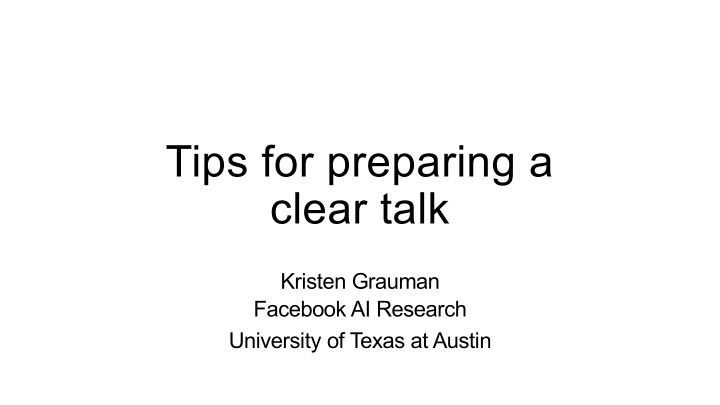



Tips for preparing a clear talk Kristen Grauman Facebook AI Research University of Texas at Austin
Disclaimer I don’t always prepare a clear talk…
Some guidelines 1. Consider the audience & event 2. Don’t bury the lead 3. Be concise 4. Give credit 5. Q&A: the unknown unknowns 6. Delivery tips 7. Clear slides
Consider the audience & event • Your group meeting? • Degree of detail • CVPR? • Degree of jargon • Job talk to entire CS • Depth vs. breadth department? • Latest vs. arc of progress • Interdisciplinary? • K-12? • Formal? Casual?
Don’t bury the lead Our idea Problem • Don’t leave contribution implicit • Reiterate and rephrase message throughout • Verbally: give salient markers; “Important”…”stress that”... • “Punchlines” for results
Be concise “I didn't have time to write a short letter, so I wrote a long one instead.” ― Mark Twain • Prep the “concept bullets” • Breathe, and use fewer words • Short text phrases (not sentences) • Not every detail needs to surface https://en.wikipedia.org/wiki/Mark_Twain
Give credit • Paint the big picture of literature for context • (Clusters of) related work & key contrasts • Give credit for borrowed slides, per slide [Slide credit: Jane Smith]
Q&A: The unknown unknowns https://duffylondon.com/product/tables/abyss-horizon/
Q&A: The unknown unknowns • Guess likely questions & prepare • Don’t skip to backup slides unless necessary • Sometimes it’s better to defer a question • Answer, then stop. • Share feedback with co-authors afterwards https://duffylondon.com/product/tables/abyss-horizon/
Delivery tips • Practice and get feedback; iterate • The first slide - what will you say? • Be loud enough • Use pauses • Flow: think through transition in and out of each slide • Qualitative examples: say something about one or two. • Manage time: stopwatch, prevent derail • If you’re skipping something, then skip it. • Think about where you want to stand / test the room. • Check the laptop, AV • Nerves: “If you’re nervous, it means you care” ~Trevor Darrell https://www.ted.com/playlists/497/practice_makes_perfect
Carefully done slides reduce cognitive load • Animation – to focus attention • Font size – 28+ for main text • Simplest visual possible to make the point • Consistency: font size, capitalization, alignment… • Avoid jitter of text placement in consecutive slides • One liners where possible • Use color to link pieces of equations • Delete “Hi my name is …” from notes of first slide! • Avoid content-free “Thank you!” slide
Some guidelines 1. Consider the audience & event 2. Don’t bury the lead 3. Be concise 4. Give credit 5. Q&A: the unknown unknowns 6. Delivery tips 7. Clear slides
Recommend
More recommend